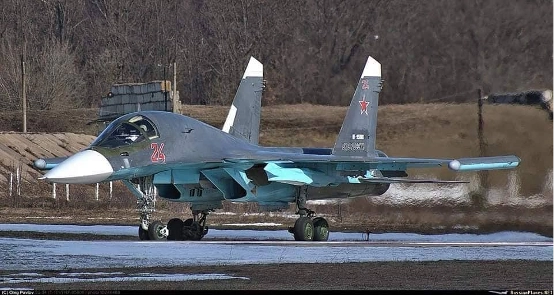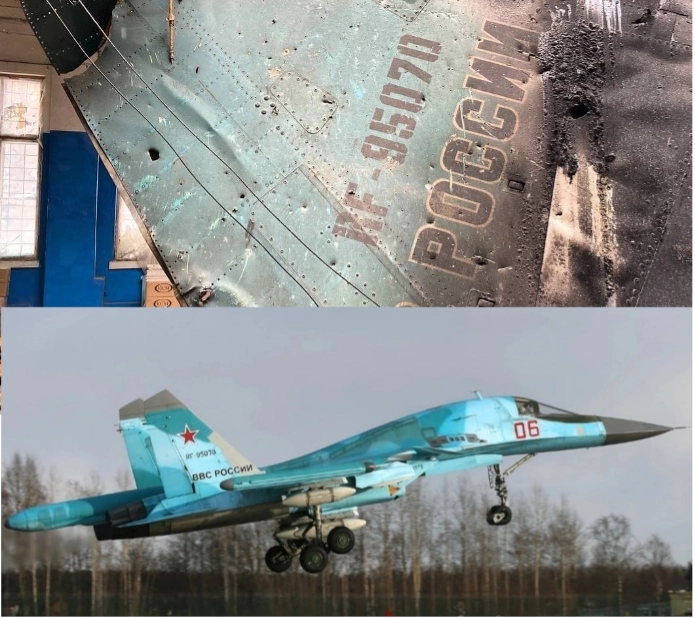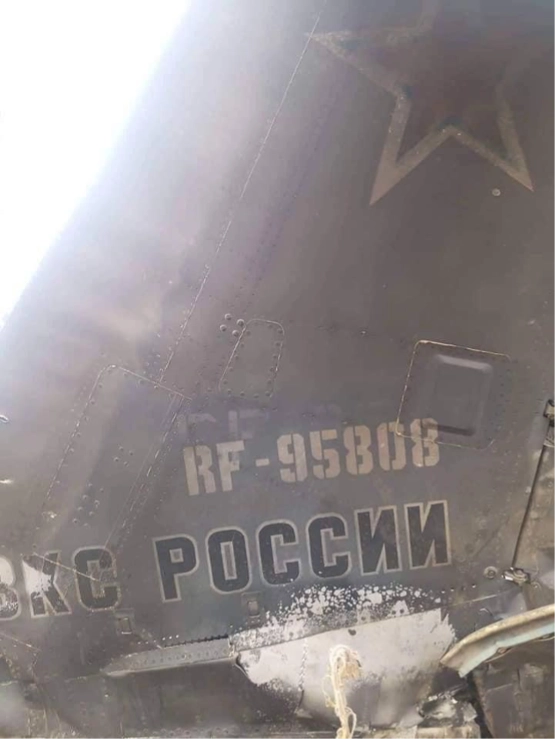The Ukrainian military is being tight-lipped on how its ground gunners just managed the shoot down of a reported thirteen (so far) of the Russia’s most advanced jets, in as many days.
But that Ukrainian and allied technicians have been able to pick over remains of multiple captured Russian airframes and their debris for more than a year and figure out ways to overcome avionics and electronic defense systems found in the debris, is well-documented.
JOIN US ON TELEGRAM
Follow our coverage of the war on the @Kyivpost_official.
A Mach-2 aircraft touted by Moscow as emblematic of modern combat systems now operated by the Russian military, the two-seater $42 million Su-34 is rated Moscow’s most advanced and best-protected fighter-bomber.
Russian air force publicity photo of an Su-34 strike jet. According to the Kremlin, this is one of the most modern and effective attack aircraft in the world today. According to Ukrainian official statements, thirteen Su-34s have just been shot down in as many days.
From Feb. 17-29 in engagements across the front, the Russian Air Force suddenly started losing aircraft and pilots to Ukrainian missiles at a disconcerting pace. By March 1 the Kyiv kill tally according to the Ukrainian military was 11 Su-34 attack jets along with two even more expensive Su-35 air superiority jets costing $85 million per airframe.
The spike in Russian losses could be explained, in part, by attempts by Moscow to push its troops westward following its capture of Avdiivka, and Russian attack jets supporting those assaults flying into air ambushes they had managed to stay out of the range of in the past, Ukrainian Air Force spokesperson Yury Ihnat said.

European Rearmament Should Avoid US Firms: Airbus
Ukraine’s Feb. 23 shoot-down of a rare $300 million A-50U AWACS (NATO reporting name: Mainstay) airplane, following the destruction of another air surveillance and traffic control plane on Jan. 13, severely reduced the Russian Air Force’s ability to monitor the front from the sky and detect incoming Ukrainian anti-aircraft missiles. The losses probably left Moscow’s ground attack pilots across the front sometimes unaware they were even being targeted, Ihnat said.
Combat pilots commonly call the unaware situation a condition of “flying fat, dumb and happy.”
“The enemy is taking losses at all these locations. Plus, we shot down two AWACS and now for three days they’re flying without AWACS at all. They’re making lots of attacks. They’re advancing and they got closer to our networks, and now they’re paying for it,” he said, in Thursday comments on the national Mi Ukraina television news program.
Ihnat said the Norwegian NASMS anti-aircraft missile system and the US-manufactured Patriot anti-aircraft missile system are in the Armed Forces of Ukraine (AFU) inventory and possess sufficient reach to hit a Russian jet venturing too close, but declined to say what actually shot the Russian planes down, or how.
Ihnat said the NASAMS fires a highly capable ground-launched version of the US-made AMRAAM air-to-air missile out to a range of about 40 km. The American Patriot, widely accounted the most effective air defense system operated by either side in the Russo-Ukrainian War, according to open sources, is capable of hitting an airplane out to about 140 km., depending on the specific missile loaded and defensive systems aboard the targeted airplane along with its radar cross-section and chosen flight path.
Ihnat denied reports, first surfacing in the newspaper Forbes on Thursday, that mobile NASMS or Patriot batteries were the authors of the recent shoot downs and claimed that once deployed powerful air defense systems like that almost always stay put.
According to the Sukhoi manufacturer, both the Su-34 and Su-35 are equipped with the most advanced avionics including a radar to find targets in the air and on the ground, an electronics warfare pod designed to trick enemy radars searching for the jet and an on-board jammer.
A key defense is a radar warning receiver that lets the pilot know, with a visual display and an unpleasant alarm sound in their headphones, that search teams aboard the A-50U and or algorithms programmed into the electronics pod on his plane failed to do their job properly, and a tracking radar or worse a hostile missile has locked onto his airplane.
According to Austrian aviation war expert Tom Cooper, a probable but as-yet unproven and unconfirmed explanation for the recent string of Sukhoi shoot-downs is the compromise of confidential defensive electronic systems aboard the Russian jets to Ukrainian and US technicians, and tweaks made to Ukrainian-operated anti-aircraft systems taking advantage of the knowledge.
A single Su-34 airframe may have come into Ukrainian possession early in the war, Cooper suggested in a Feb. 29 blog entry. The most likely US agency to do the research and countermeasure development is the National Air and Space Intelligence Center, formerly the Foreign Technology Division of the US Air Force, he said.
Possible research and countermeasure development could focus on determining when a pilot might detect an incoming missile and how the electronic warfare pod might identify Ukrainian missiles and radars to try to spoof them, and identifying frequencies the radar warning device searches for threats on, and then using other frequencies to attack the Russian jet.
Compromise of even one of the more than half-dozen electronic defense systems could, military aviation analysts say, lead a pilot into thinking the skies around them are safe because their instruments say so, at a time when they are actually being targeted. Combat pilots commonly call the situation a condition of “flying fat, dumb and happy.”
According to Kyiv Post research, at least two Su-34 air frames, both damaged, have fallen into Ukrainian hands. Kyiv Post researchers could not confirm electronics aboard the plane surviving the crashes was forwarded to NATO nation avionics experts for evaluation and counter-measures development or their condition.
The first aircraft was, according to images and multiple reports from the time, shot down on March 1 or 2 2022 and captured by Ukrainian forces in the Kharkiv sector. Ukrainian troops photographed the registry number RF-95070 (usually on an aircraft tail or nose) and identified the plane as part of a unit based in central Russia. The volunteer-associated Telegram channel DeepState published the images on March 2 2022 and the official Ukrainian government platform republished them, and others, on March 7 of that year.
Images of a piece of debris purportedly of a Russian Su-34 attack jet shot down on March 1 or 2 2022, and captured by Ukrainian forces in the Kharkiv sector, and an older image of the aircraft with the same tail number operating over Russia in peacetime. The volunteer-associated Telegram channel DeepState published the images on March 2 and the official Ukrainian government platform republished them, and others, on March 7. Ukrainian army spokesmen said the shoot-down did take place, however, the claims have never been confirmed independently.
The second Su-34 attack jet was found by Ukrainian troops advancing in the Kharkiv sector in September 2022. The Ukrainian government information platform Operativny ZSU on Sept. 13, 2022, reported the registry number of the aircraft was RF-94808, and that the aircraft had been operated by Russia’s 47th Aviation Regiment based in Voronezh.
A third Su-34 shot was videoed falling to Earth following a missile hit on Apr. 25 in the skies near the Kharkiv region town of Balakliya, but it’s not clear if the airframe was the same or different from the one with the number RF-94808.
A Russian aircraft (reportedly a Su-34) has crashed in Balakliya, Kharkiv Oblast.https://t.co/xh23sG7hbO pic.twitter.com/XaZTxGjLiK
— Rob Lee (@RALee85) April 25, 2022
Aside from entire aircraft, Ukrainian forces have captured critical components that would be predictable targets for research and counter-measure development. One of the widest-reported was the Sept. 2022 recovery by Ukrainian troops of an RTU 518-PSM self-protection jamming pod, a cutting edge defense system, on a crashed Su-30 fighter jet. The Su-34 and Su-35 both typically carry the pod.
Image purportedly of a fragment from a Russian Su-34 attack jet found by Ukrainian troops advancing in the Kharkiv sector in Sep. 2022. The Ukrainian government information platform Operativny ZSU on Sep. 13 2022 reported the tail number of the aircraft was RF-94808, and that the aircraft had been operated by Russia’s 47th Aviation Regiment based in Voronezh. The Ukrainian claim has not been confirmed independently.
Ihnat said he would not comment on new capacities of Ukrainian air defense systems past noting that development is always ongoing. But now Russian pilots approaching Ukrainian positions “may think twice,” he said.
You can also highlight the text and press Ctrl + Enter
















